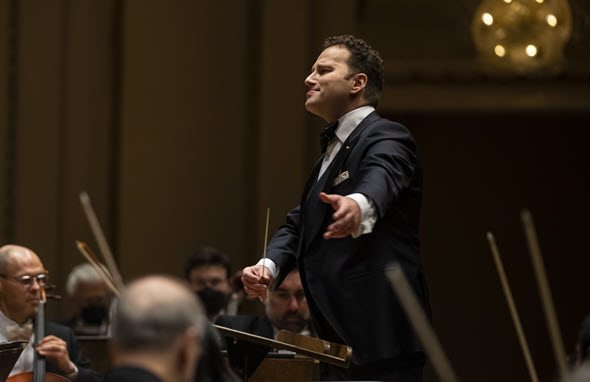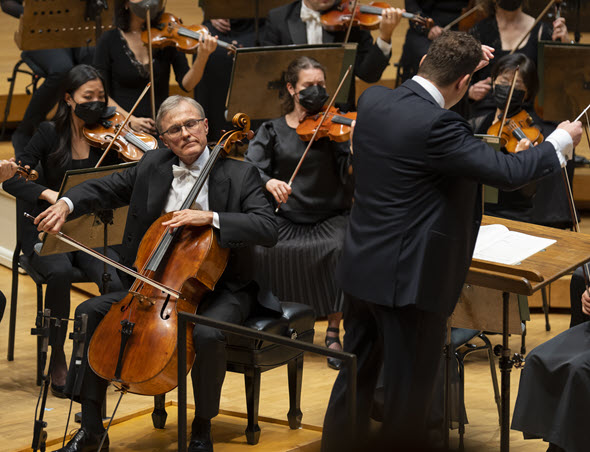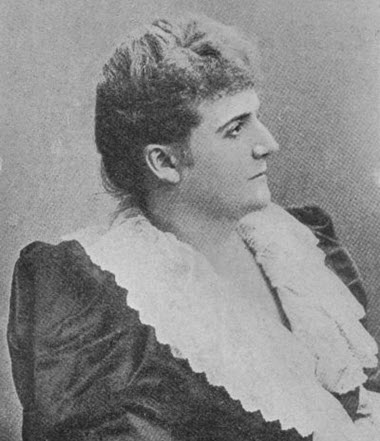Chicago Symphony, out of the pandemic gate, shines with the season’s first guest conductor

Danish conductor Nikolaj Szeps-Znaider has appeared every few years with the Chicago Symphony Orchestra since 2000. (CSO photos by Todd Rosenberg)
Review: Chicago Symphony Orchestra conducted by Nikolaj Szeps-Znaider; John Sharp, cello. Repeats at 8 p.m. Oct. 16, 3 p.m. Oct. 17 at Orchestra Hall.
By Lawrence B. Johnson
It was almost startling, like cold water in the face. For the first time this season, which is to say for the first time since the pandemic shut down the Chicago Symphony Orchestra those endless months ago, the band was playing – four weeks into its revival season – under a conductor other than music director Riccardo Muti. I was actually conscious of making the mental adjustment. Muti is a galvanizing presence, and his reopening three weeks had seen the CSO make an instant leap back to its wonted virtuosic form.
Now here was a fresh face on the podium: the Danish violinist-turned-conductor Nikolaj Szeps-Znaider. But by the end of this 85-minute concert sans intermission, I would gladly have returned to hear the program centerpiece, Schumann’s Symphony No. 2 in C major, a second time.
Szeps-Znaider, 46, made his CSO debut in 2000, back in the Daniel Barenboim era, as a violinist (at the time still known simply as Nikolaj Znaider) playing the Sibelius concerto with the orchestra’s then-music director on the podium. He last appeared three years ago wielding both bow and baton to perform the Beethoven concerto. I’ve never understood why musicians insist on doing such double duty, this dog-and-pony show of playing and conducting concertos “from the violin” or “from the keyboard.” It’s invariably problematic in terms of interpretive precision and nuance, and indeed I still remember that Beethoven for what it was not. (More’s coming in the season’s second half when pianist Mitsuko Uchida plays and conducts two Mozart concertos with the touring Mahler Chamber Orchestra. She’s done her Mozart spiel several times with the CSO, ever reminding one of the collaborative importance of a wholly focused conductor.)
Here, we got Szeps-Znaider with his head fully engaged in Schumann’s exuberant Second Symphony. Indeed, he conducted the work with the music entirely in his head, without a score. His mastery showed in a thousand details – from the music’s sunny tunes and infectious, energizing rhythms to an uncommon subtlety, luminosity and eloquence in his layering of woodwind voices. The brilliant, boisterous scherzo gave way to a languid Adagio where Szeps-Znaider’s artfully shaped fugato section clearly pointed back to the model of Beethoven’s grand fugue in the Adagio of the “Eroica” Symphony. An almost steely clarity marked every measure of the performance, and yet the conductor never lost sign of the music’s essential humanity, its vitality and warmth.
The Chicago Symphony responded with an edge-of-seat performance, alert and crisp and at the same time altogether radiant. Schumann’s four symphonies sometimes come under technical scrutiny, as inspired essays that don’t always stand up to, well, proper German analysis. Szeps-Znaider’s free-spirited, headlong and committed account of the Second – and an orchestra performance that belied the pandemic’s great interval – seemed to banish those caveats. In its elegant contours and glorious colors, in its irrepressible spirit, this was a roundly convincing traversal of the Second Symphony.
The concert also showcased one of the Chicago Symphony’s own when principal cellist John Sharp stepped forward as soloist in Saint-Saëns’ evergreen Cello Concerto No. 1 in A minor. The impression on this night was very much en famille, a beloved concerto transfigured as chamber music among longtime colleagues. Intimacy stamped Sharp’s caressing turn, with the orchestra’s collective expression scaled to fit. Szeps-Znaider proved to be a sensitive collaborator, but this was one time when old friends might have gone on their soulful way with no need of a guiding stick. Sharp’s playing exuded a well-measured blend of finesse and charm, and his teammates were right there with him.
Szeps-Znaide opened his program with a fetching rarity, “La nuit et l’amour,” a poetic purple patch for orchestra by the late 19th-century Irish-French composer Augusta Holmès. A protegee of César Franck, Holmès, as a woman, was not allowed to study composition at any French conservatory, but it’s easy to see how she might have been taken under so great a wing. Her orchestral evocation of “night and love” is assured, original and gorgeous. Who knew? The answer today is that almost no one has any consciousness of Augusta Holmès, who like other women composers of past generations struggled in vain against the tide of gender bias. Happlly, we appear to be at the onset of a historic correction.
Just ahead are two weeks of CSO programs with conductors standing in for the orgiinally scheduled guest, Michael Tilson Thomas, who has been sidelined by surgery to remove a brain tumor. In his place Oct. 21-23 will be James Conlon leading Shostakovich’s Chamber Symphony, Op. 110a, Schubert’s Symphony No. 3 and Prokfiev’s Piano Concerfto No. 1 with soloist Alexander Gavrylyuk. The following week, Oct. 28-30, Manfred Honeck conducts Schubert’s Symphony No. 8 in B minor (“Unfinished”), Prokofiev’s Piano Concerto No. 3 with soloist Denis Matsuev and “Coincident Dances” by CSO resident composer Jessie Montgomery.





I’m with you, Lawrence B. Johnson, on wanting to hear the Schumann again (and the rest of the program as well).
I was at Friday’s performance, am returning for Sunday’s matinee performance, and very much looking forward to it. A return visit for the same program is a first for this long time CSO subscriber. It was a beauty of a program and performance in all respects I think.